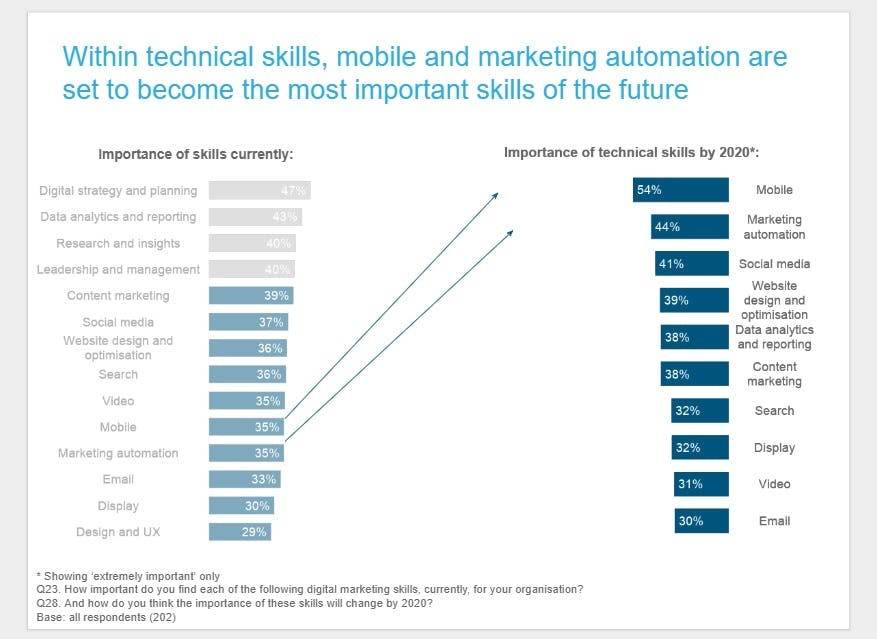How to Develop a Successful Marketing Automation Strategy
Process automation is a global trend and the goal of almost any ambitious company. Automation of Marketing – is no exception. According to the Digital Marketing Institute, this benefits in a 14% Sales efficiency increase and a 12% reduction in marketing expenses.
Nevertheless, the reality is harsher than many might expect, with purchased software licenses tend to gather dust on the shelf, and the majority of a team reach their data-processing maximum via MS Excel – solely.
A successful marketing automation strategy is not all clear sailing in calm waters, so we’ve compiled a few best practices to develop it.
What is a Marketing Automation Strategy?
Marketing automation supposes assigning major routine marketing operations to software, with people continuing to perform tasks that machines cannot deliver. Therefore, managing diverse marketing channels is backed up by numbers, is more predictable, and is scalable.
While organizations strive for big data and move online, a talent to execute marketing automation will become one of the top-level technical skills by 2020.

Here are just a few basic marketing tasks that are either completely or most part handled by programs:
- Real-time bidding
RTB systems identify users via cookies, pixel tags, or other benchmarks and conduct auctions among ad providers – to show the most appropriate banner or text ad to every viewer. Add to that a sole bidding may last 100 ms or less, and you get an amount of work that no human can do.
- Advertising on SERPs
Google, Bing, Yandex, and Baidu – search engines are not selfless assistants for the common people; they’re true money-gen giants. To generate profits, they were equipped with AI and mind-blowing data-proceeding potentials. For example, a single paid ad on the Google results page is presided by extensive operations, such as assessing keywords’ and ads’ content eligibility, determining the user’s language and location, calculating Ad Rank, etc. The system recommends bids, spending limits, and best-performing keywords and gives prospects. Again, no individual can perform these jobs by hand.
- Email drip campaigns
Email automation is vital for subscription-based businesses, e-commerce websites, B2C lead generation, or whatever purpose-heavy outreach. The software can speed up the process, form complete email sequences, and help you achieve marketing or sales goals. Furthermore, you risk being banned for spam without a reliable email validator like Hunter.
Both Facebook and LinkedIn offer excellent tools to automate led gen. You don’t need to turn into a detective to find leads’ profiles and target them – the system will perform this for you. The only good-to-have inputs are a list of leads’ emails, quality visuals, and consistent content.
- Multichannel activities management
If you perform cross-channel marketing (and we hope you do), you can also automate the alliance and timing. Marketing programs support integration with mailing services, CRMs, and numerous tracking software. Your leads, conversions, and sales data will be transferred between programs that will autonomously process it and, far more – generate strategic insights. Who says this isn’t a dream of every business?
Developing a successful marketing automation strategy
To obtain benefits from marketing automation, it’s important to understand when to launch it and how. There are three undersized yet frequent traps in the matter:
- Failing to consolidate different funnel stages
This is a common problem of either sales, marketing, or lead gen funnels’ automation. While the “How to..” issue is more or less clear, dealing with middle and BOFU causes challenges on top-of-the-funnel stages.

Say, you need to increase brand awareness. You choose to launch a series of tutorial videos on YouTube to accomplish this goal. You create an account, navigate to Studio, create and upload video – you make these all arise. After a while, the system provides automatically processed statistics about achievements, such as views, watch time, and click metrics.
The puzzle is – how to advance with collected data through the sales funnel. Is it possible to automatically push engaged users toward consideration, decision, and purchasing steps, or is human mediation irreplaceable?
The truth is that automation tries may be stuck at some point. And – that’s okay. Thorough analytics leads’ to nurturing, content creation, and strategic planning – nevertheless, these demands involve people. The only issue is whether your company can find an optimal manual and machine labor blend.
- Distortion of scaling
Another prevalent automation pitfall is focusing on existing potential instead of trying to grow it. Consider a shallow but illustrative example. You have a leads database that grows by 2% per month. You purchase a program that will speed up data gathering and processing ten times monthly. A tempting yet wrong business decision is to utilize software to work out existing databases only. Because in this case, within a couple of months, your marketing team will utterly be “out of stock” with leads. Instead of shuffling in-use information, spend time and money on automating new information gathering – for as much as possible.
- Mere analysis experiences
Employees are the biggest asset in reaching computerization intentions. Even though you’ve obtained the ever-best software licenses, equipped the office with up-to-date hardware, and developed distinct procedures, without people able to handle these – efforts will be money down the drain. Not surprisingly, businesses spend huge amounts of money on employee training – in the US alone, these expenses amounted to $83 billion (!) in 2019. Neglecting human resources’ developing and hard wages’ cutbacks – these are two automation success-killers, indeed
Understanding where to use automation
Automation is usually required within the following areas of activities:
- Lead generation
- Conversions’ tracking and optimization
- Email newsletters
- On-site and video advertising
- CRM.
Hence, sales and marketing are at the frontier of administering automation efforts. You should think about it if the company undergoes one or several of the following:
- The substantial and firmly growing flow of leads
- The need for detailed customer journeys and Buyer personas emerged
- You plan to perform cross-channel lead nurturing.
- You plan to scale the business – either horizontally or vertically.
Remember that marketing automation isn’t a guarantee of success. It’s a somewhat desirable environment to boost efficiency metrics. Consider these ideas to adopt automation:
- Mapping customers’ experience
- Creating personalized or dynamic ad content, including visuals
- Designing clients’ re-engagement
- A\B tests
- Sales predictions with AI
- Auto-responding and drips.
Establish benchmarks
In most cases, the automation leads to scaling and vice versa. To scale successfully, an in-depth relationship between actions and results is required. In other words, to control marketing automation, you require benchmarks.
But it’s not that simple. 50% of experts say that measuring automation performance is the biggest challenge of the entire process. The rescuing idea is to track 3 groups of metrics:
- Quantitative
These are “number of…” such as emails sent, ads’ impressions, filled-in contact forms, etc.
- Behavioral
Do your efforts change leads’ reactions? Use click-through, open rates, and “cost-per-…” metrics to track behavioral efficiency.
- Response
How adequately do your efforts align with the audience’s readiness to respond to them? To measure customers’ engagement, use multidimensional relative metrics. For example, the number of purchased subscriptions to the number of registered App users – for a given period.
Research and Development
Marketing is not just about creativity, ideation, brainstorming, and conceptualization. Research and development shall follow every stage of the process to generate a positive ROI from automation expenses. Companies in developed economies like the UK can even apply for tax relief on their Digital Marketing R&D activities. These usually include:
- Producing pieces of helpful computer code
- Designing databases
- Developing algorithms to work with business intelligence.
Automation provides endless opportunities to enhance marketing development, without a doubt.
Lead nurturing
Automated leads’ nurturing is a major part of all inbound campaign efforts. Studies show that 77% of buyers want to consume distinct content – at different stages of their purchasing journey. 35-50% of sales are obtained by vendors who were the first to respond to requests. Thus, responding quickly and with relevant content is key to accelerating sales. The right software, a few settings – and your lead nurturing will advance to the very next level:
- Email automation programs
Quickly extract a valid email address from the long list, send and respond to thousands of letters with minor human involvement. Think of MailChimp, Snov.io, OptinMonster, Sendinblue, and others.
- Campaigns management tools
Synchronize CRM, SMM, email drips, and major client-facing marketing activities. Think of Salesforce, Basecamp, Trello, and others.
- Content automation programs
Produce engaging content and perform multiplatform scheduled publications. Think of Elink.io, CoSchedule, Zapier, and others.
- “All-in-one” lead’s nurturing software
Create custom segments, score leads, and launch campaigns through a single “control center.” The most popular programs are Nutshell, Leadboxer, HubSpot, and others.
Benefits of using an effective marketing automation strategy
If executed accurately, marketing automation will bring several perks to your company. To name the TOP-3 – better content targeting, customer experience, and leads’ quality.

Scaling of best-performing approaches will turn into increased marketing ROI, teams’ productivity, and strategic goal completion. Other principal advantages include:
- More qualified leads acquisition
- Data quality and reliability
- Better opportunities to measure marketing performance
- Increased cross-team cooperation
- Better client retention
- Shortened sales cycle.
Despite marketing automation seeming challenging, investing in software, personnel, and process advancement will pay off. Even though you may not encounter real perks from the beginning, with business enlargement and increasing demand for a company’s products, the advantages of self-adjusting sales and marketing actions will be clearer.






